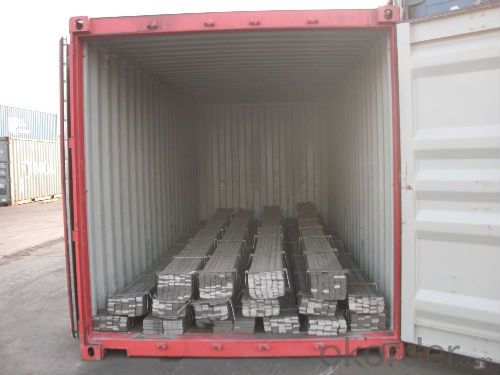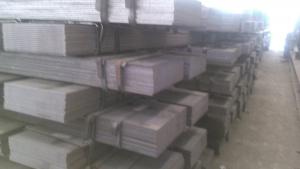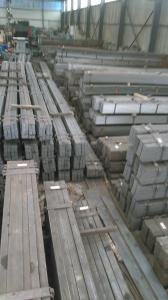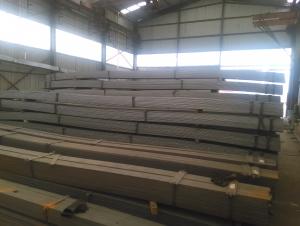Steel Flat Bar Grade JIS SS400 B Added
- Loading Port:
- Tianjin
- Payment Terms:
- TT or LC
- Min Order Qty:
- 50 m.t.
- Supply Capability:
- 10000T m.t./month
OKorder Service Pledge
OKorder Financial Service
You Might Also Like
Product Description:
OKorder is offering Steel Flat Bar Grade JIS SS400 B Added at great prices with worldwide shipping. Our supplier is a world-class manufacturer of steel, with our products utilized the world over. OKorder annually supplies products to African, South American and Asian markets. We provide quotations within 24 hours of receiving an inquiry and guarantee competitive prices.
Product Applications:
Steel Flat Bar Grade JIS SS400 B Added are ideal for structural applications and are widely used in the construction of buildings and bridges, and the manufacturing, petrochemical, and transportation industries.
Product Advantages:
OKorder's Steel Flat Bar Grade JIS SS400 B Added are durable, strong, and wide variety of sizes.
Main Product Features:
· Premium quality
· Prompt delivery & seaworthy packing (30 days after receiving deposit)
· Can be recycled and reused
· Mill test certification
· Professional Service
· Competitive pricing
Product Specifications:
Manufacture: slited
Slitting precision (width) : 0.5 mm or less
Raw material: Q235B, Q345B, Q235-1 b
crosscutting precision (length) : 2 mm or less
Processing: the thickness of 2.0-16 mm;
Shear length: 2000 mm above
Wide degree: 15-1250 - mm;
Leveling precision: 1-2 MM square
Packaging: Export packing, nude packing, bundled
FAQ:
Q1: How many tons of steel products could be loaded in containers?
A1: Usually the steel products are delivered by bulk vessel because of the large quantity and the freight. However, there are no bulk vessel enter some seaports so that we have to deliver the cargo by containers. The 6m steel product can be loaded in 20FT container, but the quantity is changed according to the size, usually from 18tons to 25tons.
Q2: what is the difference between actual weight and theoretical weight?
A2: All the section steel has two weights: actual weight and theoretical weight. Actual weight is the weighing out when the product delivered from the mill. Theoretical weight is calculated by pieces. The invoice can be based on each of them as your request.
Q3: How soon can we receive the product after purchase?
A3: Within three days of placing an order, we will arrange production. The normal sizes with the normal grade can be produced within one month. The specific shipping date is dependent upon international and government factors, the delivery to international main port about 45-60days.
Images:


- Q:Are steel flat bars available in different colors or coatings?
- No, steel flat bars are typically not available in different colors or coatings. Steel is typically left in its natural state, which is a dark gray or silver color. However, it is possible to apply coatings or finishes to steel flat bars for specific purposes such as protection against corrosion or to enhance its appearance. These coatings can include galvanized coatings, which provide a layer of zinc to protect against rust, or powder coatings, which can add a layer of color to the steel. However, these coatings are typically applied after the steel has been formed into the flat bar shape and are not readily available in a wide range of colors or finishes.
- Q:How do you join two steel flat bars together?
- Depending on the desired strength and aesthetic appeal of the final joint, there are various methods available for joining two steel flat bars. One commonly used technique is welding, where the two flat bars are heated until they reach a molten state and then fused together using either an electric arc or a gas flame. This process results in a robust and durable joint, but it requires skill and specialized equipment to be executed effectively. Additionally, welding can leave visible weld marks that may require smoothing or finishing. Alternatively, mechanical fasteners such as bolts, screws, or rivets can be employed. This method involves drilling holes through both flat bars and subsequently securing them together using the chosen fastener. Mechanical fasteners offer a sturdy joint and can be easily dismantled if necessary. However, they may not provide the same level of strength as welding and may also be visible, depending on the selected fastener. Another option is adhesive bonding, which involves using a high-strength adhesive specially designed for bonding metal. The adhesive is applied to the contact surfaces of the flat bars, and then they are firmly pressed together until the adhesive cures. Adhesive bonding can yield a strong and visually appealing joint, although its strength may not match that of welding or mechanical fasteners in certain applications. Ultimately, the most suitable method for joining two steel flat bars together depends on the specific requirements of the project. It is advisable to consult with a professional or an experienced metalworker to determine the optimal joining technique for your particular needs.
- Q:What are the different shapes available for steel flat bars?
- There are several different shapes available for steel flat bars. The most common shape is the rectangular flat bar, which has a straight, flat surface and sharp edges. This shape is often used for structural applications, such as building frames and supports. Another shape is the square flat bar, which has equal width and thickness on all sides, forming a square shape. This shape is commonly used for ornamental purposes, such as decorative trim or fencing. Additionally, there are also round-edged flat bars available, which have rounded corners instead of sharp edges. This shape is often preferred for applications where safety is a concern, as the rounded edges reduce the risk of injury or damage. Some manufacturers also offer special shapes, such as tapered flat bars or custom profiles, which are designed to meet specific requirements or to provide unique functionality for certain applications. Overall, the available shapes for steel flat bars provide a range of options to suit different needs and preferences, allowing for versatility and customization in various industries and projects.
- Q:Are steel flat bars suitable for the construction of retail spaces or shopping centers?
- Yes, steel flat bars are suitable for the construction of retail spaces or shopping centers. They are strong, durable, and can be easily fabricated and installed. Steel flat bars also provide stability and support to the structure, making them an ideal choice for commercial construction projects.
- Q:How do steel flat bars perform in earthquake-resistant designs?
- Steel flat bars are commonly used in earthquake-resistant designs due to their high strength and ductility. Their ability to withstand strong seismic forces and distribute them evenly across the structure makes them an ideal choice. Additionally, steel flat bars can be easily connected and reinforced, enhancing the overall stability and resilience of the building during an earthquake.
- Q:What are the common finishes for steel flat bars?
- Some common finishes for steel flat bars include hot rolled, cold rolled, galvanized, and polished.
- Q:Can steel flat bars be used for manufacturing medical devices?
- Medical devices can indeed be manufactured using steel flat bars. Steel boasts versatility as a material, offering a broad range of properties including strength, durability, and corrosion resistance. Consequently, it finds suitability in various applications within the medical field. When it comes to crafting medical devices like surgical instruments, orthopedic implants, and prosthetics, steel flat bars can be easily manipulated and formed into the necessary shapes. Moreover, they prove efficient in terms of sterilization and cleaning, a crucial factor for upholding hygiene standards in medical settings. Nevertheless, it is worth noting that the specific grade and type of steel required may vary depending on the device and its intended purpose. It is imperative to adhere to pertinent industry standards and regulations throughout the manufacturing process.
- Q:Can steel flat bars be used for DIY projects?
- Yes, steel flat bars can be used for DIY projects. They are versatile and can be easily cut, shaped, and welded to fit various project needs. Whether it's for creating shelves, furniture, brackets, or structural supports, steel flat bars offer strength, durability, and a sleek modern look.
- Q:The steel, steel and flat steel, round steel bar and what is the difference?
- On the whole, the square section is square, flat section is rectangular, steel surface after finishing the round steel or steel wire (also called steel, silver bar).
- Q:How is a steel flat bar manufactured?
- A steel flat bar is manufactured through a process known as hot rolling. This process involves heating a large rectangular steel billet until it reaches a malleable temperature. The billet is then passed through a series of rolling mills, where it is gradually compressed and shaped into a flat bar. The first step in manufacturing a steel flat bar is the preparation of the steel billet. The billet is typically made of carbon steel and is cast into a rectangular shape. It is then reheated in a furnace to a temperature that allows for easy shaping and manipulation. Once the billet reaches the desired temperature, it is fed into a series of rolling mills. These mills consist of a series of rollers that gradually reduce the thickness and shape of the steel billet as it passes through. The rollers apply a tremendous amount of pressure to the billet, which causes it to elongate and take on the desired flat shape. As the billet passes through the rolling mills, it is cooled and lubricated to prevent overheating and excessive wear. Water or air jets are often used to cool the steel, while lubricants such as oil or emulsions are applied to reduce friction and improve the surface finish. After several passes through the rolling mills, the steel billet is transformed into a flat bar with the desired dimensions. The bar is then cut to the required length and allowed to cool. Once cooled, it may undergo additional processes such as straightening, surface treatment, or quality inspection before it is ready to be shipped or used in various applications. Overall, the manufacturing process of a steel flat bar involves heating the steel billet, passing it through rolling mills to shape and reduce its thickness, and then cutting and cooling the bar to its final dimensions. This process ensures that the steel flat bar is produced with the necessary strength, durability, and surface finish required for its intended application.
1. Manufacturer Overview |
|
|---|---|
| Location | |
| Year Established | |
| Annual Output Value | |
| Main Markets | |
| Company Certifications | |
2. Manufacturer Certificates |
|
|---|---|
| a) Certification Name | |
| Range | |
| Reference | |
| Validity Period | |
3. Manufacturer Capability |
|
|---|---|
| a)Trade Capacity | |
| Nearest Port | |
| Export Percentage | |
| No.of Employees in Trade Department | |
| Language Spoken: | |
| b)Factory Information | |
| Factory Size: | |
| No. of Production Lines | |
| Contract Manufacturing | |
| Product Price Range | |
Send your message to us
Steel Flat Bar Grade JIS SS400 B Added
- Loading Port:
- Tianjin
- Payment Terms:
- TT or LC
- Min Order Qty:
- 50 m.t.
- Supply Capability:
- 10000T m.t./month
OKorder Service Pledge
OKorder Financial Service
Similar products
New products
Hot products
Related keywords






























